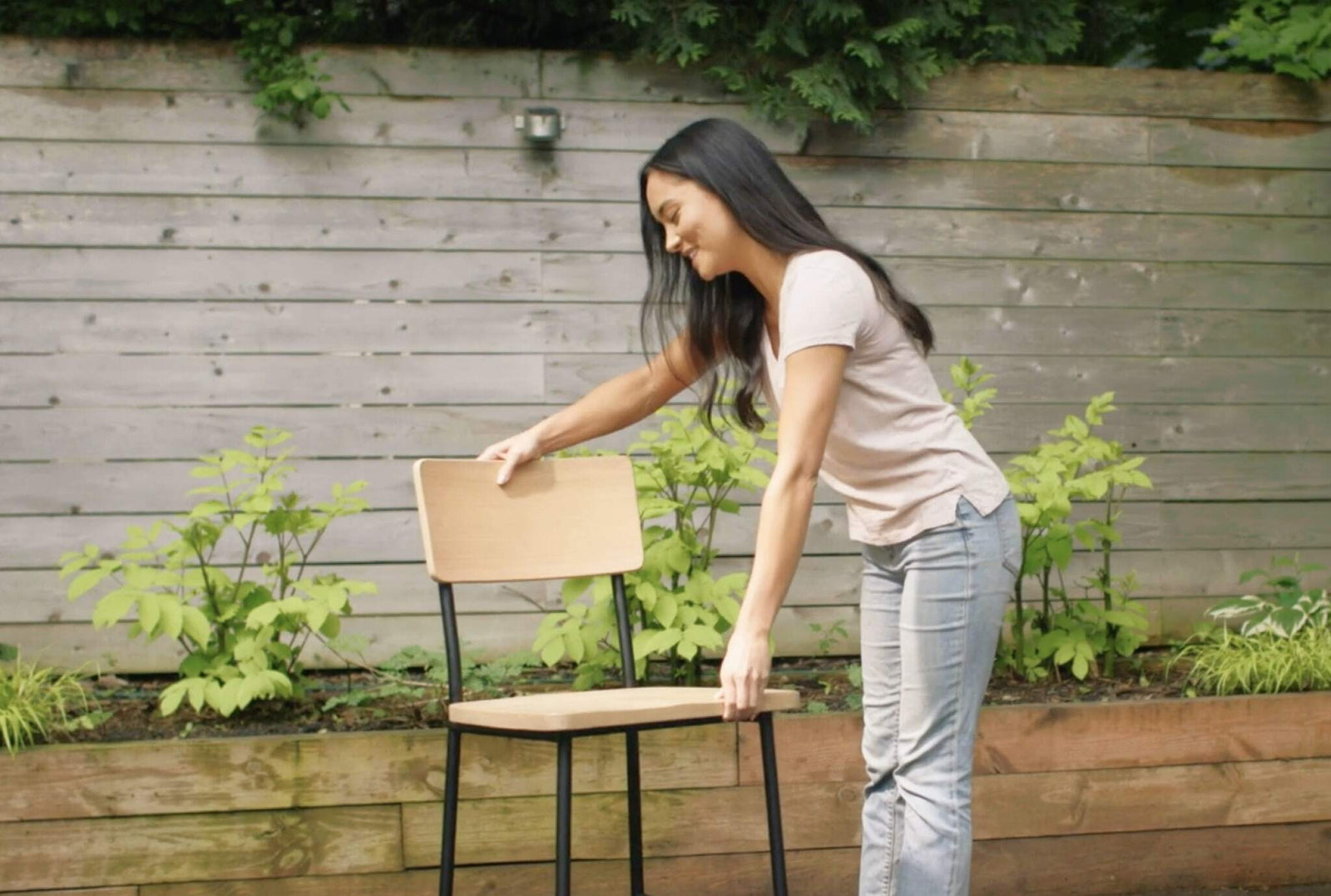Non-Toxic Christmas Trees

Real vs. Artificial Trees: An Honest Look at Pros & Cons
The holidays are here! If your plans include purchasing a Christmas tree, you are in very good company. It’s that time of year when families bundle up and go to a Christmas tree farm or perhaps your family favors an artificial tree for the convenience, consistency, and cleanliness. Whichever tree option you plan on trimming, there is debate over which variety (real or artificial) is better for the environment and us humans. Truly, each type of tree has its merits and drawbacks in terms of individual human and environmental impact. All of which should be considered when making a conscious decision on the best tree tradition for you and your family.
Real Christmas Trees
There is nothing like the smell of a fresh spruce or pine tree to usher in the tidings of the season. Natural aroma aside, a real tree brings a peaceful and tranquil setting to your home that, in our opinion, an artificial tree can’t quite match! However, real trees have their challenges too.
Pros of Real Christmas Trees
- They smell amazing and may help clean the air in your home (just like they clean the air outside).
- Buying from a local tree farm helps support your economy.
- As Christmas trees are planted and grown, they provide habitat for wildlife, help draw down carbon and air pollutants, and provide jobs.
- They’re grown specifically to be Christmas trees, so you’re not hurting a forest by cutting them down.
- You can buy them live and actually replant for a zero-waste, environmentally-friendly option you’ll get to enjoy for years to come.
- Organic/sustainably-grown trees are available in many parts of the country. Check out greenpromise.com for farms and locations.
- Trimmings work great for decorations.
- Children (and truly the whole family) usually love the tradition of going out to pick out a tree - whether from a lot or a local farm.
- They do not contain lead, aluminum, phthalates, flame retardants, or other plastic-based chemicals that could outgas from an artificial tree.
- They are biodegradable, compostable and can be chipped for mulch.
- Real trees do not require storage.
- Should you be allergic to pine, there are hypoallergenic varieties to choose from: spruce, cyprus and/or fir. The Leyland Cypress, for example, is a 100% hybrid non-pollen-producing tree. Live trees typically transplant quite well.
- Per the National Christmas Tree Association, for every 1 tree cut down the farmer plants 1 or more saplings in its place.
1 This means by buying a live tree you’re actually helping plant more trees in its place. - When you buy from a local farm you save tons of carbon emissions vs. buying an artificial tree shipped from overseas or a live tree shipped from hundreds of miles away.
- They do not contain toxic flame retardants which are considered endocrine and neurodevelopmental disruptors and carcinogens.
2
Cons of Real Christmas Trees
- It's a process to pick one out, pay for it, and drag it home every year.
- It takes gas to get to a Christmas farm, which means you’re emitting carbon.
- Many Christmas trees are sprayed with pesticides, including glyphosate (aka RoundUp), which have been shown toxic to human cells
3 and have been linked to cancers,4 neurodevelopmental disorders in children,5 birth defects,6 and much more. - Most (but not all) real trees drop pine needles which require cleaning.
- Pine needles can be hazardous to pets if ingested.
- Real trees, whether live or cut, require watering, so they are typically higher-maintenance than artificial in this area.
- Like all plants, they may contain pollen, dust and mold which can cause irritation to those who are sensitive. They can be a fire hazard if not properly watered, decorated carelessly or left lit unattended.
- They must be properly discarded and/or recycled every year.
Tips For Choosing A Healthier Real Christmas Tree
- Avoid pesticides by either buying from an organic tree farm. If this is not an option, call ahead to find out when they spray the trees. Ideally, you’ll want to buy a tree that is either not sprayed at all, has been sprayed sparingly or hasn’t been sprayed for several weeks.
- If you have allergies to pine, consider an hypoallergenic tree, like a Leyland Cypress or other appropriate native tree to your area. Shaking out your tree at the lot/tree farm and spraying it down with water can help with this. A freshly cut tree, like a live tree you choose on a tree farm then have cut down for you, typically has less chance of mold and dust because they are not stored in a shed, barn, etc. before sale. The same goes for live trees you dig up that day. If you’re allergic to pine pollen, see above for alternatives and check with your local tree farm as hypoallergenic varieties vary state-to-state.
- Consider a live tree rental service. That way the company will pick it back up and replant it for you. Unfortunately, this isn't available everywhere. A quick Google search can help you find some in your area.
- Try and choose a tree farm or lot close to your home to avoid excess carbon emissions.
- Keep your tree watered to avoid it becoming a fire hazard.
- Dust your ornaments before placing them on the tree.
- Use incandescent bulbs whenever possible. LEDs emit blue light which has negative consequences for your circadian rhythm and pets/wildlife.
- Recycle your tree by composting or turning it into mulch vs. dumping it in a landfill.
- Never burn your holiday tree in a fireplace or wood burning stove! Though it will smell great, most pines, firs, spruces, etc. when heated will spray sticky sap onto your chimney creating a messy fire hazard. If you want to burn your tree, do it in a designated fire pit outdoors.
- HEPA vacuum up pine needles and around the tree regularly to minimize allergens and keep pine needles away from pets.
Artificial Christmas Trees
Artificial trees have become wildly popular over the last several years, with approximately 75-80% of Americans who put up a tree each year opting for artificial.
Pros Of Artificial Christmas Trees
- They set up in minutes.
- They don’t drop needles.
- They don’t harbor pollen which can cause allergies or allergic reactions in some people.
- They are less likely to harbor mold (although note this is depending on how and where they’re stored).
- Some come pre-lit, saving time and sanity (because who wants to untangle a big mess of lights only to find out half the strand is not working!).
- They don’t require watering or trimming.
- They save money long-term.
- They can be less of a fire hazard.
- Can be safer for pets who may pull them down, ingest pine needles which can harm their intestines, get into the dirty water, etc.
- They look beautiful, don’t dry out, and require no trimming.
- They last for years and years, saving you the hassle of annual procurement and disposal.
- You’ll have lots of sizing and decor options available.
- Thanks to consumer push-back, there are now safer artificial trees that contain less harmful chemicals.
Cons Of Artificial Trees
- Most artificial trees are made of PVC (plastic), which is one of the most environmentally offensive non-renewable plastics. Plus, PVC trees contain lead and aluminum.
- They are not recyclable, and eventually need to be thrown out.
- Most are made in China (approximately 80%), which means they have a significant carbon footprint.
- Artificial trees may contain artificial fragrance, which is loaded with endocrine-disrupting chemicals and other toxins.
- Since they’re plastic, artificial trees may initially emit VOCs which you can take care of by outgassing first. Once the VOCs are gone, plastics also emit SVOCs, and phthalates - all of which ride on dust and degrade indoor air quality. These chemicals can be held in check during the Christmas season by regular HEPA vacuuming.
- Most types contain flame retardants, also an SVOC which rides on dust, which are highly toxic to children, pets, and humans in general. Once again, regular HEPA vacuuming will reduce this issue.
- Artificial trees require storage and should be stored in an area free from mold.
- Artificial trees have no natural pine scent.
- Prelit trees usually have LED lights, which aren’t optimal for humans or pets due to the circadian-disrupting blue light they emit.
- Pre-lit trees with non-LED bulbs will eventually burn out, leaving you the hassle of having to pull off the lights and relight the tree.
- Artificial trees can collect a lot of dust, which harbors various toxins.
Tips For Choosing A Healthier Artificial Tree
- First and foremost, look for non-PVC, flame-retardant-free, fragrance-free trees. Thanks to pushback from consumers, these are now available and do not (or should not) contain lead or aluminum.
- Note: We've heard IKEA’s artificial trees meet these standards, but it’s worth double-checking as materials may have changed due to manufacturing challenges this year.
- For new trees, outgas outdoors in the sunlight or outdoors until there are no remaining smells from VOCs that emanate from the materials. Wipe down your tree before decorating (they can harbor a lot of dust!).
- Non-PVC or not, artificial trees are still made of plastic so we recommend wearing gloves when setting up your tree (especially if it’s PVC and contains flame retardants).
- Do not use artificial pine scent or scented candles! Instead, opt for organic/wildcrafted pine, spruce, essential oils or non-toxic candles.
- If your tree is PVC and/or contains flame retardants, do not allow children to touch it without gloves as they are especially vulnerable to the effects of these toxins. If you’re pregnant or nursing, take a pass on decorating this year. Potential lead exposure is not worth it!
- Your HEPA vacuum is your best friend when you have an artificial tree. HEPA vacuum around the tree regularly to suck up any treeborne chemicals that may be riding on dust. Why? Once the VOCs have been outgassed, regular HEPA vacuuming will keep SVOCs like flame retardants, phthalates, and other chemicals in check.
- Wipe down your tree before storing, dry completely, and store in a sealed plastic bin in a very dry environment (not a damp basement!). This will help prevent mold and mildew from growing on it.
- If your tree does look moldy when you get it out of storage, it’s not worth the risk! Don’t risk exposing you or your family to the health detriments of toxic mold by trying to salvage it.
The Bottom Line
When it comes to human and environmental health, there are obviously pros and cons to each type of tree.
If you’re very concerned about chemicals at home and in the environment, a real or live Christmas tree will likely be your best bet. On the other hand, if you have pets who will eat pine needles, you cannot go out to get a tree, or are pretty allergic to pollen - a non-PVC, fragrance-free, non-flame-retardant artificial tree is most likely a better option for you.
Regardless, follow the safety and care tips and you’ll help preserve your indoor air quality, avoid major toxins, and enjoy your beautiful tree for weeks to come. Happy holidays!
Categories

Marilee Nelson
Marilee Nelson is an Environmental Toxins expert who has spent nearly 30 years advocating for the chemically-sensitive and chronically-ill. She is a Board Certified Nutritionist, Certified Bau-Biologist and Bau-Biology Inspector and specializes in Food As Medicine. She has helped thousands of families and individuals identify, heal and recover from toxic exposures and is on a mission to revolutionize the way American families view their health.








